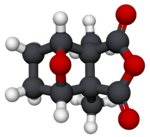
Back کانتاریدین AZB Cantaridina Catalan Kantaridin Czech Cantharidin German Κανθαριδίνη Greek Cantaridina Spanish Kantaridina Basque کانتاریدین Persian Kantaridiini Finnish Cantharidine French

| |

| |
| Names | |
|---|---|
| Preferred IUPAC name
(3aR,4S,7R,7aS)-3a,7a-Dimethylhexahydro-4,7-epoxy[2]benzofuran-1,3-dione | |
Other names
| |
| Identifiers | |
3D model (JSmol)
|
|
| 85302 | |
| ChEBI | |
| ChEMBL | |
| ChemSpider | |
| ECHA InfoCard | 100.000.240 |
| EC Number |
|
| KEGG | |
PubChem CID
|
|
| UNII | |
CompTox Dashboard (EPA)
|
|
| |
| |
| Properties | |
| C10H12O4 | |
| Molar mass | 196.202 g·mol−1 |
| Density | 1.41 g/cm3 |
| Melting point | 212 °C (414 °F; 485 K) |
| Pharmacology | |
| None | |
| Topical | |
| Legal status | |
| Hazards | |
| Occupational safety and health (OHS/OSH): | |
Main hazards
|
Highly toxic |
| GHS labelling: | |
 
| |
| Danger | |
| H300, H315, H319, H335 | |
| P261, P264, P270, P271, P280, P301+P310, P302+P352, P304+P340, P305+P351+P338, P312, P321, P330, P332+P313, P337+P313, P362, P403+P233, P405, P501 | |
| NFPA 704 (fire diamond) | |
| Lethal dose or concentration (LD, LC): | |
LD50 (median dose)
|
0.03–0.5 mg/kg (human) |
Except where otherwise noted, data are given for materials in their standard state (at 25 °C [77 °F], 100 kPa).
| |
| Clinical data | |
|---|---|
| Trade names | Ycanth, others |
| License data |
|
| Routes of administration | Topical |
| Legal status | |
| Legal status |
|
| Identifiers | |
| CompTox Dashboard (EPA) | |
| ECHA InfoCard | 100.000.240 |
| Chemical and physical data | |
| Formula | C10H12O4 |
| Molar mass | 196.202 g·mol−1 |
Cantharidin is an odorless, colorless fatty substance of the terpenoid class, which is secreted by many species of blister beetles.[a] Its main current use in pharmacology is treating molluscum contagiosum and warts topically.[2] It is a burn agent and poisonous in large doses, and has been historically used as aphrodisiacs (Spanish fly). In its natural form, cantharidin is secreted by the male blister beetle, and given to the female as a copulatory gift during mating. Afterwards, the female beetle covers her eggs with it as a defense against predators.
Poisoning from cantharidin is a significant veterinary concern, especially in horses, but it can also be poisonous to humans if taken internally (where the source is usually experimental self-exposure). Externally, cantharidin is a potent vesicant (blistering agent), exposure to which can cause severe chemical burns. Properly dosed and applied, the same properties have also been used therapeutically, for instance, for treatment of skin conditions, such as molluscum contagiosum infection of the skin.
Cantharidin is classified as an extremely hazardous substance in the United States, and is subject to strict reporting requirements by facilities that produce, store, or use it in significant quantities.[3]
- ^ "Ycanth- cantharidin solution". DailyMed. 25 July 2023. Archived from the original on 29 August 2023. Retrieved 28 August 2023.
- ^ https://www.fda.gov/drugs/news-events-human-drugs/fda-approves-first-treatment-molluscum-contagiosum
- ^ As defined in Section 302 of the U.S. Emergency Planning and Community Right-to-Know Act (42 U.S.C. 11002). See "40 C.F.R.: Appendix A to Part 355—The List of Extremely Hazardous Substances and Their Threshold Planning Quantities" Archived 25 February 2012 at the Wayback Machine (PDF) (1 July 2008 ed.). U.S. Government Printing Office. Retrieved 29 October 2011.
Cite error: There are <ref group=lower-alpha> tags or {{efn}} templates on this page, but the references will not show without a {{reflist|group=lower-alpha}} template or {{notelist}} template (see the help page).
